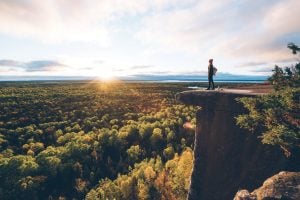
People & Culture
Kahkiihtwaam ee-pee-kiiweehtataahk: Bringing it back home again
The story of how a critically endangered Indigenous language can be saved
- 6310 words
- 26 minutes
This article is over 5 years old and may contain outdated information.
People & Culture

Todd and I were in Nain, Labrador last week getting ready to head out into the wilds of Nunatsiavut and Nunavik. I’d conducted a bunch of interviews already to get a perspective of the landcsape from the Labrador Inuit and others who’ve lived on the land and the coast here for generations.
On the two-day ferry ride up, I interviewed Captain Robert Gillard of the MV Northern Ranger, a Canadian ice-breaking ferry, who’s plied the coastal waters of Newfoundland for 54 years. Since he began his career in the late 1960s he’s noticed that the drastic change in the ice pack: it now goes out a month earlier than it used to and arrives a month later — a full two-month difference.
In Nain, I visited the Nunatsiavut (Inuit Labrador) Government building to chat with Sarah Leo, the president of Nunatsiavut. After a 21-year career with the Canadian military that included two tours in Bosnia, she returned home and was elected in June. Her four-year term will shape the future of the region as they work to create a flourishing society that protects the land and values which form the backbone of Inuit identity and livelihood.

I next took a tour of the Community Freezer with Katie Winters, who runs the freezer as well as youth programs that teach local kids their centuries-old ways of living with the land. The freezer is a communal bank of country food — traditional Inuit fare such as caribou, Arctic char and seal that hunters and fishers donate to feed elders and others in the community who cannot go out on the land to harvest the food themselves. Country food is healthier and cheaper for the local people than western food — healthier in that, well, it’s healthy — as well as countering diseases like diabetes that western diets have created among the Inuit. It’s cheaper in that it allows the Inuit to be self-sufficient for food and less dependent on the severely expensive products brought in from the south.

Johannes Lampe, the minister of Culture, Recreation and Tourism, has lived much of his life on the land. He explained that Nunatsiavut means “Our beautiful land,” and that it has always provided everything his people need. He also gave us an interesting little tidbit: his ancestors used to smear themselves in caribou or seal blood to protect from the notorious mosquitoes and blackflies that are part of the atmosphere up here in the summer. If we run out of Deet, that may be our back-up plan.
Seventy-nine-year old elder Jacko Merkuratsuk lived on the land for 20 years before being moved into Nain. The move was difficult in that it removed him from his traditional hunting territory in the north into a new region he didn’t know. There were many lean years as he struggled to provide food for his wife and family away from his home grounds. In a terrible winter storm in 1979, he rescued numbers of people in his party who were caught out in the open by building an igloo to shelter them. He then marched out in the blinding whiteout and back to the coast to bring in rescuers. Even his heroic effort could not save everyone as two of the party perished. Only one of the bodies was ever found.
Humbled by this fresh perspective of the land and its connection with the Inuit people, we headed out into the land, eager to experience it for ourselves.
Documentary filmmaker and writer Frank Wolf and a fellow canoeing enthusiast will travel 1,400 kilometres from Nain, NL to Kuujjuarapik, Que., and document their journey through film and articles. The duo plans to share the Inuit perspective of the land through interviews with members of the communities of Nain and Kuujjuaripik. Read more of Frank’s blog posts and learn more about their expedition on the Royal Canadian Geographical Society website.
Are you passionate about Canadian geography?
You can support Canadian Geographic in 3 ways:

People & Culture
The story of how a critically endangered Indigenous language can be saved

Travel
The new movement building flourishing tourism hubs across Canada – one sustainable example at a time

People & Culture
For generations, hunting, and the deep connection to the land it creates, has been a mainstay of Inuit culture. As the coastline changes rapidly—reshaping the marine landscape and jeopardizing the hunt—Inuit youth are charting ways to preserve the hunt, and their identity.

History
A look back at the early years of the 350-year-old institution that once claimed a vast portion of the globe